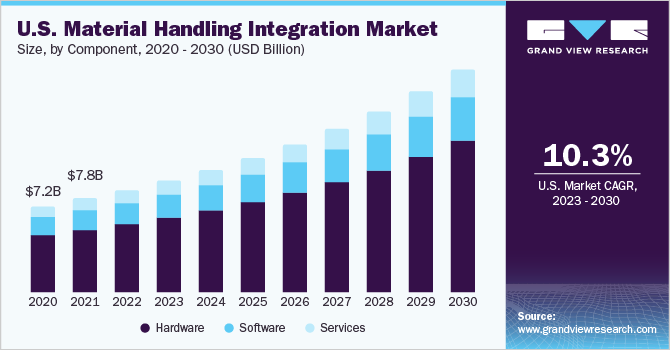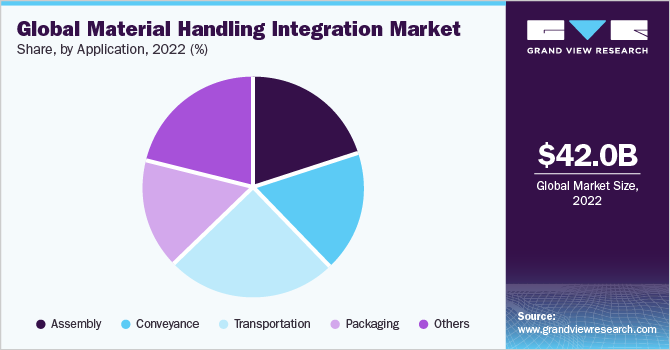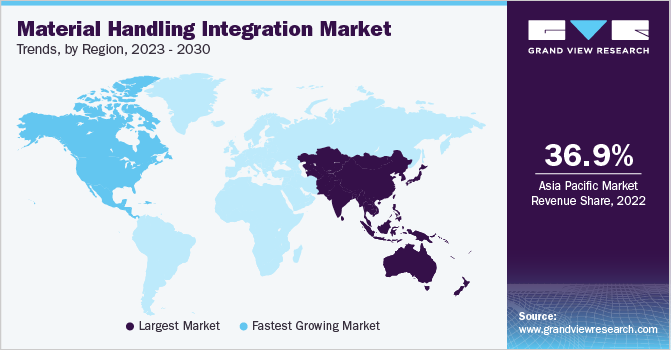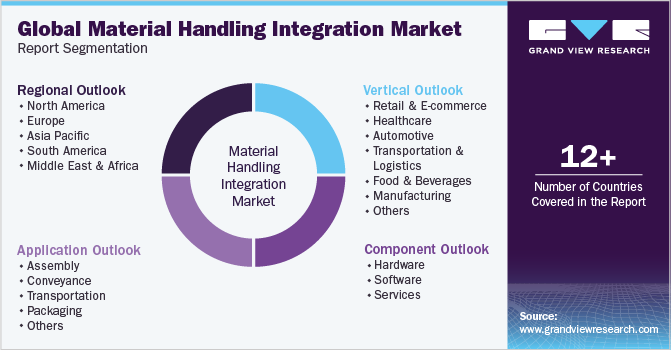
Material Handling Integration Market Size, Share & Trends Analysis Report By Component (Hardware, Software), By Application (Assembly, Packaging), By Vertical, By Region, And Segment Forecasts, 2023 - 2030
- Report ID: GVR-4-68040-105-3
- Number of Report Pages: 120
- Format: PDF
- Historical Range: 2017 - 2021
- Forecast Period: 2023 - 2030
- Industry: Technology
Report Overview
The global material handling integration market size was estimated at USD 42.0 billion in 2022 and is expected to grow at a compound annual growth rate (CAGR) of 8.9% from 2023 to 2030. The increasing global adoption of e-commerce is a significant catalyst for adopting material handling integration systems. With millions of shipped products globally daily, the demand for efficient material handling systems has skyrocketed. In the fiercely competitive e-commerce industry, major players rely heavily on these systems to enhance operational efficiency. In addition, it enhances operational efficiency by optimizing the flow of materials, minimizing delays, and reducing errors.

By streamlining processes and coordinating equipment and software, businesses can achieve smoother operations, increase productivity and cost savings. Material handling integration refers to seamlessly incorporating various components and systems involved in moving, storing, and controlling materials within a business operation. It entails the strategic coordination and synchronization of equipment, software, and processes to optimize these activities' efficiency, productivity, and safety.
Through effective integration of these elements, businesses can streamline their supply chain, reduce costs, minimize errors, and enhance overall operational performance. Furthermore, these systems provide scalability and adaptability. They can be customized to meet the specific requirements of diverse industries, allowing businesses to handle diverse materials and accommodate changing production requirements. This flexibility enables businesses to adapt to market demands quickly and efficiently.
Material handling integration is critical across diverse industries, including manufacturing, logistics, retail, and healthcare. In manufacturing, it enhances production efficiency, minimizes downtime, and enables precise just-in-time inventory management. Within logistics, it facilitates seamless movement and tracking of goods, reducing transit time and improving visibility within the supply chain. In the retail industry, material handling integration enables efficient order fulfillment, mitigates out-of-stock situations, and boosts customer satisfaction. Finally, in the healthcare sector, it ensures the accurate and timely delivery of medical supplies and equipment, ultimately enhancing the quality of patient care.
COVID-19 Impact
The global markets experienced a downturn due to mandatory shutdowns and stay-at-home orders implemented to curb the spread of COVID-19. This led to a significant increase in layoffs and a reduction in planned expansions across various industries. In 2020, the International Labor Organization (ILO) estimated that approximately 400 million jobs were lost worldwide during the second quarter of 2020 due to the impact of COVID-19. This subsequently impacted the market for material handling integration as well.
The pandemic accelerated the pace of automation and digitalization across industries. It is also likely to accelerate the adoption of warehouse automation owing to benefits such as lower delivery times and enhanced efficiency offered by material handling integration solutions, including Automated Storage and Retrieval Systems (AS/RS) and integrated inventory management software, enabling warehouses to address challenges associated with labor and unpredictable demand management. Post the pandemic, warehouses implemented scalable processes to handle unpredictable demand using material handling integration technologies. The solutions' flexibility and efficiency help warehouses handle order demand peaks. Hence, the material handling integration industry witnessed significant growth opportunities post the pandemic.
Component Insights
In terms of component, the market is segmented into hardware, software, and services. The hardware segment led the global market in 2022 with a revenue share of more than 68.0%. The hardware segment is further categorized as Automated Storage and Retrieval Systems (AS/RS), conveyors, Automated Guided Vehicles (AGVs), and robotics. Hardware in the material handling integration industry refers to the physical equipment and devices used to facilitate the movement, storage, and control of materials within various industries.
The hardware is integrated with the material handling integration software solutions to provide a comprehensive view of the material handling process across a warehouse or distribution center. Market players provide hardware solutions, such as AGVs and AMRs, for material handling and launching new products. Increasing automation across multiple industries and the availability of a wide range of material-handling hardware products are likely to drive the growth of the hardware segment.
The services segment is anticipated to witness the fastest CAGR of 9.4% throughout the forecast period. The material handling integration services encompass two main categories: professional and managed services. As businesses across various industries adopt warehouse automation technologies, the demand for material handling integration services is increasing. This demand is primarily driven by the complexities involved in integrating and implementing material handling systems effectively. To enhance customer experience, the majority of the players in the market offer services that cater to their specific needs.
With providing comprehensive material handling services including customized solutions, the customers can focus on their core expertise while entrusting material handling integration operations to the experts. This approach allows businesses to optimize their resources and achieve greater efficiency. Consequently, the material handling integration services segment is expected to witness substantial growth, fueled by the increasing adoption of automation and the wide availability of services, along with hardware and software solutions.
Application Insights
Based on application, the market is segmented into assembly, conveyance, transportation, packaging, and others. Among these, the transportation segment dominated the market in 2022 with a revenue share of more than 25.0%. Assembly refers to combining separate components to create a final product. For example, fitting tires into cars before shipment involves assembly. In warehouse operations, assembly lines are commonly used, where product parts are passed along the line and assembled at different stages until the final product is completed.
The increasing complexity of products and the need for agile assembly processes drive the adoption of solutions that integrate material handling. Material handling equipment such as conveyors and Automated Storage and Retrieval Systems (AS/RS) are utilized in assembly lines. Conveyors enhance the assembly process flow, while AS/RS systems can store workpiece components during assembly for future production. AccuBilt, Inc., a U.S.-based automation integration service provider, offers a range of assembly and material handling products for various applications, including Pick and Place (PNP).

The packaging segment is anticipated to witness the fastest CAGR of 10.4% throughout the forecast period. Packaging is crucial to safeguarding materials during storage, distribution, and transportation. It encompasses various components, such as pallets, dunnage, unitizers, and containers, employed in manufacturing and warehouse settings. These packaging components come in diverse sizes, shapes, and materials. With the rise of e-commerce, businesses are increasingly offering customized packaging options to provide optimal shopping experiences for customers.
These factors drive the adoption of solutions, integrating material handling in packaging applications. Conveyors are pivotal in holding or accumulating materials or products for packaging or subsequent processing. In addition, software solutions like Warehouse Management Software (WMS) control multiple warehouse operations, including packaging activities. By integrating material handling solutions, the overall efficiency of the packaging process can be significantly enhanced.
Vertical Insights
Based on vertical, the market is divided into retail & e-commerce, automotive, healthcare, food & beverages, transportation & logistics, manufacturing, and others. The retail & e-commerce segment led the market in 2022 with a revenue share of more than 22.0%. The retail and e-commerce segment involves the sale of goods or services to end-consumers, either through physical brick-and-mortar stores or online marketplaces. This sector has experienced significant disruptions in recent years, with a booming online retail industry and increasing adoption of omnichannel distribution.
Retailers encounter various challenges, such as meeting customer expectations for a seamless experience across channels, faster order-to-delivery cycles, and a rise in returns due to the surge in e-commerce. In response to these challenges, there is a high demand for efficient, error-free order processing in the retail and e-commerce sectors. This has driven the adoption of solutions that integrate material handling to manage changing consumer behavior and support the growth of e-commerce. Material handling integration solutions provide businesses with cost reduction and efficiency improvement opportunities.
The food & beverages segment is anticipated to grow at a considerable CAGR of 11.2% throughout the forecast period. The food and beverage industry encompasses businesses involved in processing, packaging, and distributing raw food materials. This industry handles a wide range of products, including packaged, fresh, prepared foods and non-alcoholic and alcoholic beverages. To ensure product quality and freshness, the industry strongly emphasizes spoilage prevention and the use of multi-temperature environments. In addition, handling fresh products and managing the replenishment of essential items present complexities within this sector.
Adopting material handling integration solutions in the food and beverage industry is driven by changing consumer preferences, such as increased consumption of convenience meals and organic foods. These solutions play a vital role in managing order fulfillment time and ensuring the quality and freshness of products. For instance, in December 2021, Swisslog Holding AG, a company based in Switzerland, provides automated warehouse solutions tailored to the food and temperature-controlled industry. With their expertise, they have successfully developed and installed over 250 deep freeze automation systems worldwide.
Regional Insights
Asia Pacific led the overall market in 2022, with a revenue share of 36.9%. Asia Pacific is a region with significant potential, accounting for approximately 60% of the global population and hosting several developing economies with a promising technology infrastructure. The increasing penetration of the internet and smartphones in the region has resulted in a significant boost in e-commerce sales. Countries such as Australia, Singapore, South Korea, and Japan exhibit high levels of technology adoption.

Several national governments in the region are actively taking initiatives to promote automation across industries. For example, the Singapore government introduced the Integrated Robotics & Automation Solutions initiative. This initiative aimed to provide financial support to construction companies adopting robotics and automation solutions to address workforce shortages in Singapore. The region is witnessing growing investments in technology and automation, alongside the rapid expansion of the e-commerce sector. These factors are expected to drive the growth of the material handling integration industry in the Asia Pacific.
North America is anticipated to grow at the fastest CAGR of 10.3% during the forecast period. North America stands as a highly technologically advanced region, characterized by a vibrant presence of numerous technology companies and widespread internet and smartphone usage. The region is also home to a considerable number of solution providers specializing in integrating material handling systems. Governments, particularly in the United States and Canada, actively support developments in this field by investing in research and development (R&D) to drive innovation. As per the Association for Advancing Automation (A3), North American companies witnessed an approximately 11% increase in robot orders in 2022, with a total of 44,196 units ordered.
Key Companies & Market Share Insights
The material handling integration market is highly competitive. The key players are adopting different development strategies such as product launches, mergers & acquisitions, and others to expand their presence and market share. Along with key strategies, these players are introducing new features to improve the customer experience.
In April 2023, Automated Handling Solutions and Advanced Material Processing announced entering a collaboration to launch a new group website aimed at enhancing customer experience and streamlining material handling operations. The group website features an integrated support system, offering prompt assistance to customers requiring technical guidance, after-sales support, or any other inquiries. Some prominent players in the global material handling integration market include:
-
Daifuku Co., Ltd.
-
Jungheinrich AG
-
Cargotec
-
KION GROUP AG
-
Honeywell International Inc
-
SSI SCHAEFER
-
KNAPP AG
-
TGW Logistics Group
-
Fives
-
FORTNA Inc.
-
Murata Machinery Ltd.
-
Swisslog Holding AG
Material Handling Integration Market Report Scope
|
Report Attribute |
Details |
|
Market size value in 2023 |
USD 45.3 billion |
|
Revenue forecast in 2030 |
USD 82.4 billion |
|
Growth rate |
CAGR of 8.9% from 2023 to 2030 |
|
Historic year |
2017 - 2021 |
|
Base year for estimation |
2022 |
|
Forecast period |
2023 - 2030 |
|
Quantitative units |
Revenue in USD million/billion and CAGR from 2023 to 2030 |
|
Report coverage |
Revenue forecast, company ranking, competitive landscape, growth factors, and trends |
|
Segments covered |
Component, application, vertical, region |
|
Regional scope |
North America; Europe; Asia Pacific; South America; Middle East & Africa |
|
Country scope |
U.S.; Canada; Mexico; UK; Germany; France; India; China; Japan; Brazil; GCC; South Africa |
|
Key companies profiled |
Daifuku Co., Ltd.; Jungheinrich AG; Cargotec; KION GROUP AG; Honeywell International Inc; SSI SCHAEFER; KNAPP AG; TGW Logistics Group; Fives; FORTNA Inc.; Murata Machinery Ltd.; Swisslog Holding AG |
|
Customization scope |
Free report customization (equivalent up to 8 analysts working days) with purchase. Addition or alteration to country, regional & segment scope. |
|
Pricing and purchase options |
Avail customized purchase options to meet your exact research needs. Explore purchase options |
Global Material Handling Integration Market Report Segmentation
This report forecasts revenue growth at global, regional, as well as at country levels and offers a qualitative and quantitative analysis of the market trends for each of the segments and sub-segments from 2017 to 2030. For this study, Grand View Research has segmented the global material handling integration market report based on component, application, vertical, and region.

-
Component Outlook (Revenue, USD Million, 2017 - 2030)
-
Hardware
-
Automated Storage and Retrieval Systems (AS/RS)
-
Conveyors
-
Automated Guided Vehicles (AGVs)
-
Robotics
-
Others
-
-
Software
-
Warehouse Management System (WMS)
-
Transportation Management System (TMS)
-
Manufacturing Execution System (MES)
-
Others
-
-
Services
-
Professional Services
-
Managed Services
-
-
-
Application Outlook (Revenue, USD Million, 2017 - 2030)
-
Assembly
-
Conveyance
-
Transportation
-
Packaging
-
Others
-
-
Vertical Outlook (Revenue, USD Million, 2017 - 2030)
-
Retail & E-commerce
-
Healthcare
-
Automotive
-
Transportation & Logistics
-
Food & Beverages
-
Manufacturing
-
Others
-
-
Regional Outlook (Revenue, USD Million, 2017 - 2030)
-
North America
-
U.S.
-
Canada
-
Mexico
-
-
Europe
-
UK
-
Germany
-
France
-
-
Asia Pacific
-
India
-
China
-
Japan
-
-
South America
-
Brazil
-
-
Middle East & Africa
-
GCC
-
South Africa
-
-
Frequently Asked Questions About This Report
b. The global material handling integration market size was estimated at USD 42.0 billion in 2022 and is expected to reach USD 45.3 billion in 2023.
b. The global material handling integration market is expected to grow at a compound annual growth rate of 8.9% from 2023 to 2030 to reach USD 82.4 billion by 2030.
b. Asia Pacific is expected to dominate the market and grow at a CAGR of 8.0%. The increasing penetration of the internet and smartphones in the region has resulted in a significant boost in e-commerce sales. Countries such as Australia, Singapore, South Korea, and Japan exhibit high levels of technology adoption.
b. Some prominent players in the material handling integration market include Daifuku Co., Ltd., Jungheinrich AG, Cargotec, KION GROUP AG, Honeywell International Inc, SSI SCHAEFER, KNAPP AG, TGW Logistics Group, Fives, FORTNA Inc., Murata Machinery, Ltd., and Swisslog Holding AG.
b. Key factors driving the market growth include the increasing global prevalence of e-commerce significantly boosting the adoption of material handling integration systems. Material handling integration enhances operational efficiency by optimizing the flow of materials, minimizing delays, and reducing errors.
We are committed towards customer satisfaction, and quality service.
"The quality of research they have done for us has been excellent."




